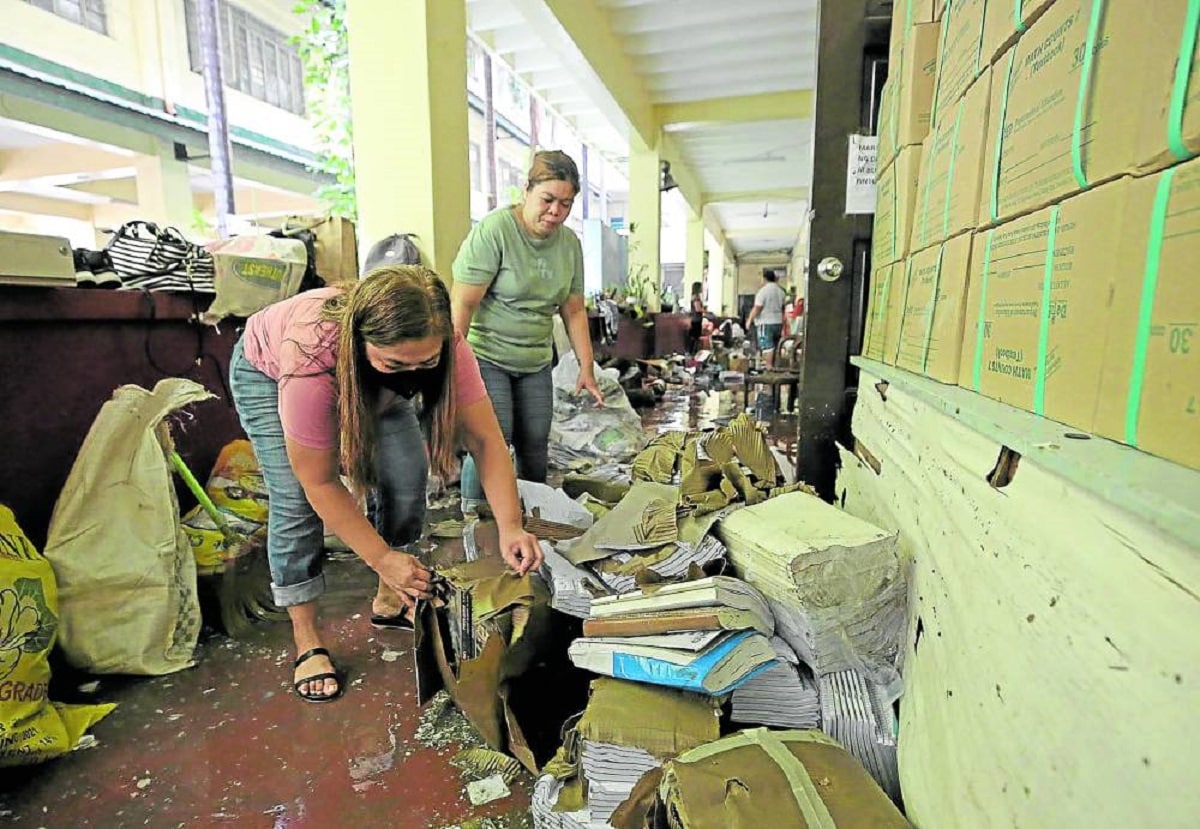
CAMPUS CALAMITY CLEANUP Three days before the opening of a new academic year, teachers, students and school personnel at Cayetano Arellano High School in Sta. Cruz, Manila, work together on Friday to clean up the mess left by the flood caused by Supertyphoon “Carina” two days earlier. The Department of Education said at least 738 schools were not yet ready. —RICHARD A. REYES
President Ferdinand Marcos Jr. on Friday urged schools to reopen as scheduled next week “as much as possible,” even if teachers have to meet their students outside classrooms as a consequence of the recent typhoon, which damaged some school buildings and turned others into emergency shelters.
He ordered the Department of Education (DepEd) to “do everything” to start classes on Monday, July 29, for school year 2024-2025.
READ: Marcos: Start of classes set Monday, flood-hit schools may need more time
“As much as possible. If the school buildings are in a condition to take classes, they will do it,” the President said, adding that it would be up to the school authorities to decide whether to do so or not.
“They can conduct classes outside of the school building,” he told reporters in an interview during his visit to San Mateo, Rizal, to inspect storm damage.“After all, that’s how things were done during the pandemic. We find ways to hold classes,” Mr. Marcos said.
He said there might be some schools that could not hold classes because they are still flooded or muddied.
The reopening of schools in July instead of August follows the administration’s decision in May to gradually revert to the old schedule when schools open in June.
The decision was in response to a public clamor prompted by complaints of extreme heat inside classrooms at the height of the El Niño weather phenomenon in the first half of this year.
New schedule
Under the new schedule, classes will end on April 15, 2025, with no need for in-person classes on Saturdays to complete the required 182 school days.The Alliance of Concerned Teachers (ACT) said it was “callous” for Mr. Marcos’ to consider holding classes outdoors. ACT said that “quality education could not be achieved in makeshift classrooms or under the trees.”
“It is a blatant insult to millions of Filipino students and teachers who have long suffered from a chronic lack of classrooms and basic educational facilities, further worsened by Typhoon Carina,” the group said in a statement on Friday.
“The government must develop an efficient system for quick assessment and repair to minimize class disruptions … It’s time to go beyond band-aid solutions like class shifting and temporary spaces,” it said.
738 schools not ready
Aside from the impact of the typhoon, Teachers’ Dignity Coalition (TDC), another teachers’ group, had pointed out that many public schools remain unprepared due to the incomplete implementation of “Brigada Eskwela,” the yearly repair and maintenance work carried out two weeks before school opening, and the unfinished training of teachers for the “Matatag” curriculum.
According to a DepEd list on Friday afternoon, at least 738 schools nationwide will not be able to reopen on Monday. These include 442 in Central Luzon, four in Cotabato, 86 in the Cordillera Administrative Region (CAR) and 206 in the National Capital Region (NCR).
Of the total, 246 schools were reportedly submerged and 425 were used as evacuation centers.
Education Secretary Sonny Angara said schools in Malabon City would start classes on July 31 while classes in Valenzuela City would begin on Aug. 5.
In a July 25 DepEd memorandum, a copy of which was obtained by the Inquirer, Angara directed that gymnasiums, learning and activity centers, auditoriums and other open spaces in schools “should be utilized first” as emergency shelters and classrooms were to be the “last resort.”
The use of schools as evacuation centers, only upon the request of a local government unit (LGU), should also be “as brief as possible,” not exceeding 15 days.
The requesting LGU and the public school administration should have a memorandum of agreement so that the roles and responsibilities of all parties—LGU, school and occupants—are outlined, according to the memo.
Angara said at a press briefing on Friday that “we’re discouraging” the use of classrooms for evacuations and that “covered courts should be the first option.”
Leo Quintilla, special assistant secretary for disaster response and management of the Department of Social Welfare and Development, said last month that the agency is urging LGUs to build evacuation centers designed for disaster response.
“We know that there is a huge impact on the education sector whenever [schools] are utilized [as evacuation centers],” he said.
He said that evacuation facilities should have kitchens, safe spaces, play areas, storage places and “conjugal rooms” for displaced individuals.
53K still in sheltersAccording to the National Disaster Risk Reduction and Management Council (NDRRMC) in a report at 8 AM on Friday, the typhoon affected 299,344 families, or 1,319,467 individuals, around the country.
Of that number, 53,414 families, or 211,396 individuals, are inside 820 evacuation centers across Regions 1, 3, 7, 9, 11, 12, Calabarzon, Mimaropa, Caraga, BARMM, Cordillera Administrative Region, and Metro Manila.
It did not specify how many of the evacuation areas were schools.
According to the DepEd, 18,370,310 students from elementary to senior high school have enrolled for schoolyear 2024-2025 as of 9 a.m. on Friday.
Of the total, 10,001,689 are elementary students, 5,577,374 in junior high school and 2,598,529 in senior high school, it said. —WITH A REPORT FROM INQUIRER RESEARCH